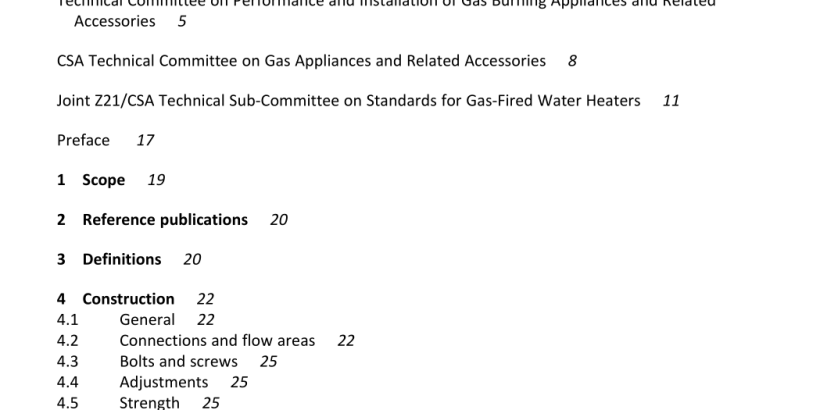CSA ANSI Z21.22-2015 pdf download.Relief valves for hot water supply systems
With the onset of the Free Trade Agreement between the United States and Canada on January 2, 1988, significant attention was given to the harmonization of the United States and Canadian safety standards addressing gas-fired equipment for residential, commercial and industrial applications. It was believed that the elimination of the differences between the standards would remove potential trade barriers and provide an atmosphere in which North American manufacturers could market more freely in the United States and Canada. The harmonization of these standards was also seen as a step toward harmonization with international standards. Joint subcommittees were established to facilitate the standards harmonization process between the United States and Canada. At its October 24, 1995 meeting, the Z21/CGA Joint Subcommittee on Standards for Relief Valves and Automatic Gas Shutoff Devices for Hot Water Supply Systems appointed an ad hoc working group to prepare a draft bi-national standard for Relief Valves. By letter ballot dated May 16, 1997, the joint subcommittee approved sending the draft standard for public review and comment. The first draft harmonized standard was based on current coverage from the American National Standard for Relief Valves and Automatic Gas Shutoff Devices for Hot Water Supply Systems, Z21.22- 1986, and the Canadian Gas Association Standard for Temperature, Pressure, Temperature and Pressure Relief Valves and Vacuum Relief Valves, CAN1-4.4-M80 (R1996). Following reconsideration and modification of the proposed draft standard, in light of comments received, the joint relief valve subcommittee at its September 30, 1997 meeting, recommended the proposed draft standard to Accredited Standards Committee Z21/83 and the (Interim CSA) Standards Steering Committee for approval. The proposed draft of the harmonized standard for automatic gas shutoff devices, as modified by the joint subcommittee, was approved by the Z21/83
Pressure — that part of a pressure relief valve which, when acted upon by a pressure in excess of that for which the relief valve is set, permits the relief valve to open and relieve the pressure in the system to which the relief valve is attached. Temperature — that part of a combination temperature and pressure relief valve (T&P valve) which operates to open the T&P valve and permit the escape of the liquid from the system when the temperature rises above a predetermined point and allows the T&P valve to close again when the temperature returns to normal. Vacuum — that part of the vacuum relief valve which, when acted upon by a vacuum in excess of that for which the relief valve is set, permits the relief valve to open and admit air into the system to which the relief valve is attached. Relief valve — a safety valve designed to forestall the development of a dangerous condition by relieving either pressure, temperature, or vacuum in a hot water supply system. Pressure relief valve — a valve that automatically opens a relief vent, when pressure reaches a predetermined value and reseats again when the pressure returns to normal. Combination temperature and pressure (T&P) relief valve — a valve that automatically opens a relief vent when either the pressure or temperature reaches a predetermined value and reseats again when the pressure or temperature returns to normal. Vacuum relief valve — a valve that automatically opens a vent for relieving a vacuum when the vacuum reaches a predetermined value, and closes again when the vacuum dissipates. Relieving pressure — the pressure at which a relief valve will pass water at the specified rate. (See Clause 5.2) Relief vent (drain) — the opening in a relief valve through which steam or water is discharged or, in a vacuum relief valve, through which air is drawn in, when the relief valve functions. Reseating pressure — the highest pressure, in a system with reducing pressure, at which a relief valve reseats to a drip tight condition. Reseating temperature — the temperaturCSA ANSI Z21.22-2015 pdf download
